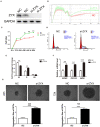Increased Expression of Zyxin and Its Potential Function in Androgenetic Alopecia
- PMID: 33505959
- PMCID: PMC7829366
- DOI: 10.3389/fcell.2020.582282
Increased Expression of Zyxin and Its Potential Function in Androgenetic Alopecia
Abstract
Androgenetic alopecia (AGA) is the most common progressive form of hair loss, occurring in more than half of men aged > 50 years. Hair follicle (HF) miniaturization is a feature of AGA, and dermal papillae (DP) play key roles in hair growth and regeneration by regulating follicular cell activity. Previous studies have revealed that adhesion signals are important factors in AGA development. Zyxin (ZYX) is an actin-interacting protein that is essential for cell adhesion and migration. The aim of this research was to investigate the expression and potential role of ZYX in AGA. Real-time polymerase chain reaction (RT-PCR) analysis revealed that ZYX expression was elevated in the affected frontal HF of individuals with AGA compared to unaffected occipital HF. Moreover, increased ZYX expression was also observed within DP using immunofluorescence staining. Our in vivo results revealed that ZYX knockout mice showed enhanced hair growth and anagen entry compared to wild-type mice. Reducing ZYX expression in ex vivo cultured HFs by siRNA resulted in the enhanced hair shaft production, delayed hair follicle catagen entry, increased the proliferation of dermal papilla cells (DPCs), and upregulated expression of stem cell-related proteins. These results were further validated in cultured DPCs in vitro. To further reveal the mechanism by which ZYX contributes to AGA, RNA-seq analysis was conducted to identify gene signatures upon ZYX siRNA treatment in cultured hair follicles. Multiple pathways, including focal adhesion and HIF-1 signaling pathways, were found to be involved. Collectively, we discovered the elevated expression of ZYX in the affected frontal hair follicles of AGA patients and revealed the effects of ZYX downregulation on in vivo mice, ex vivo hair follicles, and in vitro DPC. These findings suggest that ZYX plays important roles in the pathogenesis of AGA and stem cell properties of DPC and may potentially be used as a therapeutic target in AGA.
Keywords: RNA-seq; Zyxin; androgenetic alopecia; dermal papilla cell; hair follicle.
Copyright © 2021 Liu, Shi, Zhang, Huang, Yang, Tang, Ma, Zhang, Wang, Zhang, Zhang, Liu, Lin, Wang and Wu.
Conflict of interest statement
The authors declare that the research was conducted in the absence of any commercial or financial relationships that could be construed as a potential conflict of interest.
Figures





Similar articles
-
Insights into male androgenetic alopecia using comparative transcriptome profiling: hypoxia-inducible factor-1 and Wnt/β-catenin signalling pathways.Br J Dermatol. 2022 Dec;187(6):936-947. doi: 10.1111/bjd.21783. Epub 2022 Sep 1. Br J Dermatol. 2022. PMID: 35862273 Free PMC article.
-
Restoration of follicular β-catenin signaling by mesenchymal stem cells promotes hair growth in mice with androgenetic alopecia.Stem Cell Res Ther. 2024 Nov 19;15(1):439. doi: 10.1186/s13287-024-04051-1. Stem Cell Res Ther. 2024. PMID: 39563459 Free PMC article.
-
Hair follicle stem cell differentiation is inhibited through cross-talk between Wnt/β-catenin and androgen signalling in dermal papilla cells from patients with androgenetic alopecia.Br J Dermatol. 2012 May;166(5):1035-42. doi: 10.1111/j.1365-2133.2012.10856.x. Br J Dermatol. 2012. PMID: 22283397
-
Innovative strategies for the discovery of new drugs against androgenetic alopecia.Expert Opin Drug Discov. 2025 Apr;20(4):517-536. doi: 10.1080/17460441.2025.2473905. Epub 2025 Mar 11. Expert Opin Drug Discov. 2025. PMID: 40029254 Review.
-
Molecular basis of androgenetic alopecia: From androgen to paracrine mediators through dermal papilla.J Dermatol Sci. 2011 Jan;61(1):1-6. doi: 10.1016/j.jdermsci.2010.10.015. Epub 2010 Nov 3. J Dermatol Sci. 2011. PMID: 21167691 Review.
Cited by
-
Role of the SOX family in cancer immune evasion: Emerging player and promising therapeutic opportunities.Medicine (Baltimore). 2025 Jan 31;104(5):e41393. doi: 10.1097/MD.0000000000041393. Medicine (Baltimore). 2025. PMID: 39889187 Free PMC article. Review.
-
Self-supervised graph representation learning integrates multiple molecular networks and decodes gene-disease relationships.Patterns (N Y). 2022 Dec 6;4(1):100651. doi: 10.1016/j.patter.2022.100651. eCollection 2023 Jan 13. Patterns (N Y). 2022. PMID: 36699743 Free PMC article.
-
Multi-omics and AI-driven advances in miRNA-mediated hair follicle regulation in cashmere goats.Front Vet Sci. 2025 Jul 9;12:1635202. doi: 10.3389/fvets.2025.1635202. eCollection 2025. Front Vet Sci. 2025. PMID: 40703926 Free PMC article. Review.
-
Immune and Non-immune Interactions in the Pathogenesis of Androgenetic Alopecia.Clin Rev Allergy Immunol. 2025 Mar 1;68(1):22. doi: 10.1007/s12016-025-09034-5. Clin Rev Allergy Immunol. 2025. PMID: 40024940 Review.
-
Editorial: Hair Follicle Stem Cell Regeneration in Aging.Front Cell Dev Biol. 2021 Nov 25;9:799268. doi: 10.3389/fcell.2021.799268. eCollection 2021. Front Cell Dev Biol. 2021. PMID: 34901037 Free PMC article. No abstract available.
References
-
- Armstrong L., Hughes O., Yung S., Hyslop L., Stewart R., Wappler I., et al. . (2006). The role of PI3K/AKT, MAPK/ERK and NF kappa beta signalling in the maintenance of human embryonic stem cell pluripotency and viability highlighted by transcriptional profiling and functional analysis. Hum. Mol. Genet 15, 1894–1913. 10.1093/hmg/ddl112 - DOI - PubMed
LinkOut - more resources
Full Text Sources
Other Literature Sources
Research Materials
Miscellaneous

